- Home
- Balogun Ojetade
The Haunting of the House of Crum Page 6
The Haunting of the House of Crum Read online
Page 6
G20. Morning Room
A large couch, four chairs, and a small table are present in this room, which also contains a beautiful tapestry depicting mythological and legendary creatures—ogres and giants, dragons, demons, etc.). The room also contains more than two dozen portraits of young women on its walls, all of which have been defaced in some way (the canvas cut with a knife, the paint smeared with dark stains, etc.). There is a set of heavy wooden double doors on the western wall that lead outside the estate. When the room is first entered these doors are magically locked, but there is a chance (2, 4 or 6 rolled on one die) that the next time the room is entered the effect is no longer active.
G21. Study
The doors to the study are locked and can be opened by Crum’s signet ring, just like the Smoking Room. The study contains an oaken table, a chair, a writing desk with its own chair, and many shelves on which can be found dusty or moldering books and paper. Most of the books have had their pages torn out, which lie scattered about the room haphazardly. The books and papers are mostly unremarkable, with a couple of exceptions (see below). Most are historical and religious texts of a mundane sort. If the characters take the time to sort through the mess of pages (and if the GM so decides), one or more of them might hold some scrap of information about either Crum’s personal history or some other topic of interest to the PCs. Crum was truly catholic in his interests, so it is not inconceivable that the study might contain a useful book or scroll. Crum’s mundane books are worth $120 in total, if taken and sold to interested parties. The two noteworthy books in the study, both of which are still in good condition, are:
Buch der Geheimnisse: This German text is less than a century old and was written by the German mage and witch, Fredrika Höffern. The work’s three parts deal with elemental, celestial, and intellectual magic. The copy in the study contains Crum’s marginal notes (in English and German), which suggest that he did not think much of Höffern’s erudition. The book is worth $25 to collectors and the curious.
The Thirteen Houses: This book is written in English by famed Negro astrologer, Milton Davis. Its primary subject matter is astrology, though there are sections devoted to many other occult topics. The book is worth $15 to collectors and the curious.
Beside the writing desk is a waste paper basket, inside of which seethes a grayish-white mass of what appears to be crumpled and torn handwritten pages. The ink on the pages is smeared and mostly illegible. Should anyone approach the basket closely or touch it (even at a distance, with a stick or other object), the mass pours out with the sound of crinkling paper and attacks. The mass exists only partially in this reality, so sections of it fade in and out of view along the creases made in the individual papers.
The mass is the physical manifestation of Crum’s anger and frustration at finding nothing within the books in this room to alleviate his boredom. Initially, the mass attacks the character that disturbed it, but after the first Round of combat it focuses its attention on all the characters. It will continue to attack until destroyed. The mass will leave the study to pursue characters that flee.
Paper Fiend: Melee: 4; Physique: 2; Will: 4. Natural Weapon (paper cuts)[Master; -3d defense against fire].
G22. Steward’s Room
Friday dwelled here in life. There is a chance that he will be here should the characters enter it (1, 2, 3, or 4 rolled on one die), unless he has been previously destroyed. If so, he will be found sitting at his small desk, hunched over a ledger book filled with figures. Unless disturbed, he will not take notice of the characters. If disturbed, he attacks them, all the while screaming for Bruce and Brice to come to his aid (roll 1d: they come if a 5 or 6 is rolled).
G23. Sitting Room
Shattered chairs and a table can be found here.
G24. Green Bedroom
The walls of this room are painted green. The remains of a bed can be found here, as well as a large bay window on the north wall. The ceiling has numerous water stains on it, as well as evidence that portions may be rotten.
G25. Green Dressing Room
The walls of this room are painted the same shade of green as those of Room G24. There are two chests of drawers here, in addition to a large freestanding closet. There is nothing of value in any of them. The ceiling shows patches of water staining.
Upper Floor
U1. Winter Dining Room
The doors to the winter dining room are both locked. The room beyond contains a large wooden table and seating for ten.
Both the table and the chairs are well preserved, though covered with dust. The room is not otherwise noteworthy.
U2. Viewing Room
The western wall of this room possesses three wooden, sliding windows through which an observer can look down on the Armory below.
U3. Library
The door to this room has been flung open, revealing that it has seemingly been ransacked. Books and papers lie scattered about the room and several bookcases have been knocked over, creating a scene of chaos. This is Crum’s “public” library, which is to say, the library he allowed strangers and guests to see. As such, like his study on the ground floor, it is largely filled only with fairly ordinary tomes, though there are many more of them here—literally hundreds. Though probably of little immediate interest to the characters, many might be valuable to collectors and antiquarians, if they could be transported.
If she has not been encountered elsewhere or destroyed, Betty Jo can be found here, attempting, in vain, to clean up the mess. Being wholly insubstantial, she cannot touch the books, no matter how hard she tries. When the PCs enter, she looks up at them with an exasperated expression and asks, “Can you help me? The Master will be here soon and he hates it when his books aren’t put away.” Her spectral form visibly shudders and fades briefly out of existence as she says the second sentence. If the characters then attempt to assist her by putting books and/or bookcases back into their “proper” places—Betty Jo no longer remembers where they truly belong; all that is important is that they not be on the floor—she will smile and then disappear. For as long as they are in the estate, so long as they do not make a mess or otherwise disturb the contents of a room, she will not attack them. However, if the PCs ignore her pleas or outright refuse to assist her, she will fly into a rage and attack.
Spending at least two Rounds examining the room reveals that the library contains books on almost any non-arcane subject. Many of the books have suffered age damage, are worm-eaten, or have missing pages; but, as noted above, there are hundreds of volumes here and the well-maintained ones outnumber the dilapidated.
U4. Gallery
This room looks down on the chapel, providing additional seating for worshipers who could not be accommodated below. It also provides a better view of the intricate artwork of the chapel’s coffer ceiling and stained glass windows. From this height, smaller details, such as depictions of demons, are visible that cannot be easily seen from the ground floor. Indeed, a careful examination from this height reveals many other works of art that create the optical illusion that the depicted objects exist in three dimensions, which gives the chapel an entirely new cast. There is a chance that Tobias may be found here (roll 1 or 2 on 1d), seemingly praying on his knees. He will immediately take note of the characters’ presence and will ask them to join him in prayer.
If they agree, he will offer a short prayer to “the Lord,” asking him for his blessing and intercession. He then gets up and leaves, returning to his room.
If the characters do not agree, he sneers and rebukes them, which causes the character with the highest Empathy in the party to suffer a -1d penalty to all rolls. This lasts until the rebuked PC seeks out Tobias and apologizes to him for his or her “impiety.”
U5. Yellow Room
The walls of this room are painted a particularly vibrant shade of yellow. The walls have been vandalized, however. Someone has crudely drawn a variety of geometric shapes on them through the use of a black pigment of some sort. There is no
furniture in the room.
U6. Guest Bedroom
Crum used this bedroom to house guests who stayed at the estate. On one occasion, he entertained a rival in the black arts, whom he whimsically slew by means of a poison that both prevented the rival’s body from decay and allowed it to retain the outward appearance of life, although it does not breathe nor does it have a heartbeat or pulse. The poisoned rival summoned an aerial entity called a Blowhard, which was bound to protect him from harm while he slept.
Because of the poison’s peculiar effect, the Blowhard still believes its master to be alive but asleep and will attack anyone who enters the room and looks as if he or she might harm him. Approaching the preserved body alone is not sufficient provocation, but attempting to loot his jewelry or other possessions is.
The sorcerer wears a ring worth $140 solely on the basis of its materials. If worn, the ring reflects any Energy Blast targeted at the wearer back at the attacker, but only once, after which the ring is simply a normal piece of jewelry.
He also has a purse in which he has three gems, each one worth $50.
The Blowhard will fight until either it is destroyed or the “attacks” against its master cease. Anyone taking an item from the body will be attacked until dead or the stolen item is returned to the body.
On a table near the bed is the rival’s last meal: a plate with some chicken bones and a glass, inside of which rests a liquid looking very much like wine. The liquid is in fact the potion Crum gave to his guest. Because of its magical nature, it has retained both its liquid state and its potency, despite being left to the elements for so long. If anyone drinks the potion, he or she must make a Physique check. Failure results in death—though, like the rival, the imbiber’s body does not decay and is in fact perfectly preserved, even years after his or her demise.
Blowhard: Burglary: 4; Marksman: 4; Melee: 5; Will: 5. Energy Blast (wind) [Master]; Phasing [Master].
U7. Waiting Room
Six chairs are found in this wood-paneled room, in addition to two small tables. The room is otherwise unremarkable.
U8. Sanctum
The door to this room is not only hidden but also locked and trapped. The lock can be opened by Crum’s signet ring—which, unfortunately for the PCs, can be found inside the secret room itself. The trap is magical in nature and, if set off, creates an Energy Blast that inflicts a Moderate, Lasting Condition to all creatures within a 10’ radius. Make a Will check: one success reduces the Condition to Moderate, Fleeting; two or three successes reduces the Condition to Minor, Fleeting; and four or more successes means no Condition is suffered at all.
Within this hidden room, Crum practiced the dark rites he hoped might give him insight into the true nature of the universe, or at least alleviate his boredom. The room is decorated with images of leering demons and other blasphemous beings. There are likewise many implements used in conjuration, summoning, and necromancy. Taken from this room, these implements might command as much as $200 from those interested in demon worship or magic. One of these implements is an ornate iron dagger that, if it successfully strikes a non-human or non-mechanical opponent, it banishes it to the Beyond (a dimension of no light and where special abilities have no effect) immediately. The dagger is destroyed in the process of so striking the opponent, however. PCs feel extremely uneasy in this room, suffering a 1d penalty to all rolls while they remain here.
In addition to the aforementioned implements, the sanctum contains Crum’s collection of magical texts. Two books in that collection are noteworthy:
Buch des Goldenen Fadens: The book is written in German by a druid using the name Engel Rothkopf. The book consists of 97 different chapters in which it teaches a variety of charms, spells, and conjurations, including how to summon and bind creatures from other dimensions. Reading the entire book (which takes 1d months to complete) grants the reader the special ability Item Summoning. The book is worth $80 to collectors and the curious.
Book of Spirits: Written in English by renowned occult scholar, Toyia Gray, this book is an extensive catalog of demonic beings, including many great princes of Hell. Bayzil (see below) is not listed among these beings. The book is worth $40 to collectors and the curious.
The collection also includes Crum’s spell-book. In life, Crum was an experienced sorcerer. His spell-book thus contains spells that mimic special abilities. The GM should choose which spells to include in the spell-book, based on what he wishes to include in his own campaign.
This secret room is also where Crum committed suicide, spilling his blood into a calabash that contained numerous herbs and potions. He hoped that this ritual would not only end his life but allow his consciousness to roam freely through the cosmos. Unfortunately, he misunderstood the nature of the ritual he was attempting and so bound himself to the grounds of his estate.
Crum’s now mummified corpse lies on the ground beside the basin, dressed in a purple silk robe covered with occult symbols. He has nothing of value on his person except a gold amulet worth $150 and a signet ring that, in addition to opening various locked rooms in the estate, is worth $100 in its own right.
In the center of the room is an unbroken summoning circle in which can be found a demon named Bayzil. Crum summoned the demon shortly before he lost interest in mortal existence and committed suicide, binding Bayzil here for the last few decades with no means of escape. The demon will attempt to trick the characters into freeing it by breaking the summoning circle (by erasing one of its chalk outlines, etc.), offering them anything they wish in return for this service. Bayzil explains (truthfully, as it turns out) that it is utterly powerless until the circle is broken and thus cannot grant the characters their reward until it is freed. Once freed, the demon attacks the characters, hoping to destroy them utterly in recompense for so many years of entrapment. While within the circle, Bayzil is immune to both physical and energy attacks; it can only be harmed if the circle is broken.
Bayzil: Converse: 4; Deceive: 6; Marksman: 6; Melee: 4; Spot: 4; Will: 8. Energy Blast (fire)[Master]; Flight; Item Summoning [Master].
U9. Oaken Room
So called because its floors and wood-paneled walls are made from oak, this room is also a favorite haunt of Henry, the page. Roll 1d: if the result is 2, 3, 4, or 5 then Henry will be found in this room, if he has not yet been encountered elsewhere or destroyed. Henry spends his time here staring out the large window on the western wall, looking at the site of the former gardens.
When the characters enter this room, if he is here, he immediately turns to greet them, asking them to join him in admiring “the beauty of the garden.” If the characters do this, Henry will ask them what they think of the (nonexistent) flowers and shrubs. Should they lie by claiming to see them or otherwise give an indication that they are simply playing along with the undead boy, he will chide them, saying, “I know they’re gone, you know; there’s no need to patronize me.” If the characters point out that the flowers are gone or that they cannot see them, Henry will smile and sigh happily, “Finally, someone who sees things as they truly are.” This act grants the PCs the benefits of +4d to any defense actions for the next 1d Turns in combat.
Attacking Henry results in a roll on the Random Event table. Henry will attempt to flee from the room and seek out Bruce and Brice for protection. Should anyone destroy Henry, in addition to the penalties to Crum’s Fun noted earlier, he or she merits Crum’s special ire:
All subsequent negative results from the Random Event table target the PC who destroyed Henry first and foremost for the rest of the time he or she is in the estate.
U10. Gallery
This chamber contains a collection of three paintings, a large stained glass window, and a screen that enables occupants to look down onto the Meeting Room (Room G15) below. The paintings all depict rustic scenes but are otherwise not noteworthy. There is also a desiccated corpse standing in front of the stained glass window, its clothing almost rotted away. The corpse carries a sword, a silver dagger, a flintl
ock pistol and a backpack devoid of any contents.
The stained glass window depicts an intricately arranged garden, full of vibrant flowers, bushes, and trees. Looking carefully at it also reveals tiny moving figures that occasionally appear from among the foliage. The figures face the viewer and appear to be saying something but no sound emanates from their mouths. Some of them also make motions or gestures that suggest they are encouraging the viewer to flee. At that point, the GM should call for a Will check by anyone looking at the window. Those who roll a success are unaffected. Those who fail swap their bodies with one of the figures in the window, who also failed in the past—past viewers are NPCs of the GM’s choice: any race, gender, age, or social status.
Removing or damaging the window immediately releases all the life forces held within it.
U11. Sitting Room
This area at the top of the stairs contains three chairs whose cushions have long since rotted away.
U12. Viewing Room
The eastern wall of this room possesses three wooden, sliding windows through which an observer can look down on the Armory below.
U13. Master Bedroom
Even in its somewhat dilapidated state, the master bedroom is beautiful. There are two large windows on the western wall, as well as a balcony (which opens freely, even when other doors in the estate are under the effects of a magic lock or other special ability). There is also a large fireplace set into the eastern wall. The walls themselves are decorated with wood carvings, bas reliefs, and tapestries, most of which are strangely well-maintained. Unlike most of the other rooms in the estate, the master bedroom is free of dust or cobwebs. If it is winter or simply cold, there is also a fire in the fireplace.

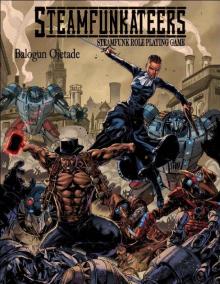 Steamfunkateers
Steamfunkateers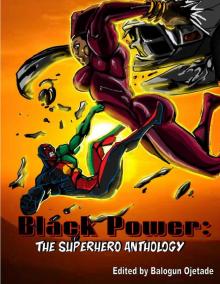 Black Power- The Superhero Anthology
Black Power- The Superhero Anthology Gunsmoke Blues
Gunsmoke Blues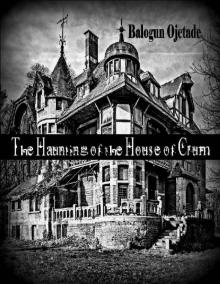 The Haunting of the House of Crum
The Haunting of the House of Crum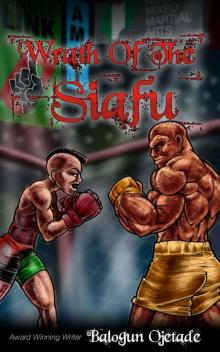 Wrath of the Siafu- A SIngle Link
Wrath of the Siafu- A SIngle Link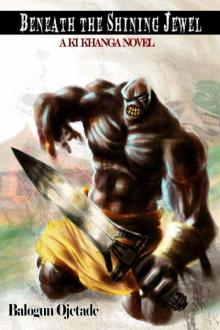 Beneath the Shining Jewel
Beneath the Shining Jewel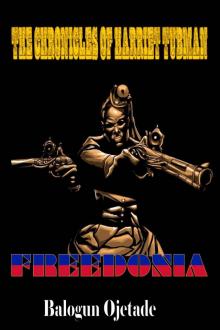 The Chronicles of Harriet Tubman- Freedonia
The Chronicles of Harriet Tubman- Freedonia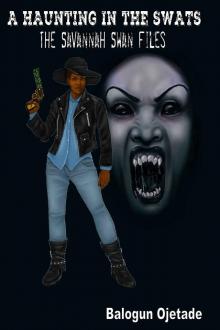 A Haunting in the SWATS (The Savannah Swan Files Book 1)
A Haunting in the SWATS (The Savannah Swan Files Book 1)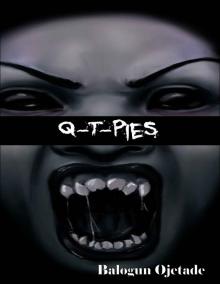 Q-T-Pies (The Savannah Swan Files Book 0)
Q-T-Pies (The Savannah Swan Files Book 0)